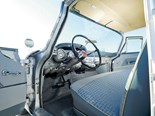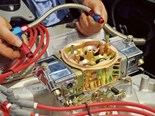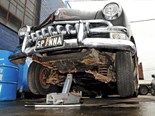Tech Talk: Tyres Explained


 The Goodyear Polyglas GT is a bias-belted cross-ply popular with classic owners
The Goodyear Polyglas GT is a bias-belted cross-ply popular with classic owners

 BF Goodrich Silvertowns: crossplies for old-school handling
BF Goodrich Silvertowns: crossplies for old-school handling

 'Cheater slicks' are popular in race events that demand street-legal tyres
'Cheater slicks' are popular in race events that demand street-legal tyres


|

|
|
The Goodyear Polyglas GT is a bias-belted cross-ply popular with classic owners
|

|
|
BF Goodrich Silvertowns: crossplies for old-school handling
|

|
|
'Cheater slicks' are popular in race events that demand street-legal tyres
|
Looking for new tyres? Here's a quick guide to the terminology
Tyres Explained
Sometimes it’s all too easy to forget just how much influence a tyre can have on how your car feels and handles. Time and again, people are genuinely shocked at how much difference it can make.
With unique cars in particular, the rubber is comprehensively screwed (to use the technical term) long before the tread has worn out. Why? Because realistically even the best of compounds will reach their use-by date in seven years. If it’s a decade or older, it’s rubbish and won’t be performing anywhere near optimum levels. The compounds will have lost their flexibility, which means the sidewalls are more than likely working against rather than with the suspension, while the grip will be seriously compromised.
It pays to think about what you’re trying to achieve – including where grip, longevity and looks fit into your budget. Inevitably there will be some compromises.
CROSS-PLY
Most modern machinery wears radial tyres (named after the belt construction) though early tyres were of cross-ply construction and they’re still available as reproductions. Cross-plies are also still used in competition applications, particularly drag racing.
The term is derived from the fact that the plies from which the case of the tyre is constructed cross over each other.
Cross-ply tyres increase in diameter as speed increases. The effect is dramatic in high-end drag racing classes, where the increase contributes to the top speed achievable by the car. On a car that has to go around corners, though, the effect is much less welcome.
When a tyre grows in diameter, the contact patch with the road is reduced. The bias-belted cross-ply tyre was introduced to control this. This construction initially featured longitudinal fibreglass belts that prevented tyre growth at speed and held the tread contact patch flatter against the road, but cross-ply sidewall construction meant they still pulled at the contact patch and distorted it during cornering.
With radial-ply tyres, the sidewalls don’t pull at the contact patch as much, providing a more stable patch and better handling. Again, longitudinal belts help maintain a flat contact patch. Early radials had fibreglass belts, but of course they’ve been steel-belted for many decades now.
In general, cross-ply tyres are said to have more ‘feel’ as they gradually lose grip. Steel-belted radials offer more grip, but less warning.
Some tyres for cars originally fitted with cross-plies are available in radial construction yet they look the same as the originals. Even drag slicks are now available in radials.
WHAT YOU’LL NEED
A clear understanding of your intended use of your tyres.
If you’re stepping away from stock sizes, get to know the regulations relating to wheel/tyre sizes and compatibility. You may also need some expert help on what will physically work without fouling.
COST
Pretty decent general tyres for larger cars seem to start around the $150 mark, but even reputable brands can be found for a bit less. It’s worth hunting around for specials as there are some extremely good deals from time to time.
From this basic price point, the sky is the limit. European brands for high-end sports cars can be several hundred dollars each or even more. The upper end is around $1000, although it’s said that the replacement high-speed run-flat for a Bugatti Veyron costs in the order of $10,000 – each, not a set! Some really high-end tyres aren’t even available without quoting a VIN.
Spending in the region of four or five hundred dollars a corner will get you a very good set of modern tyres and also pretty much whatever you might need in terms of vintage and remanufactured classic tyres. That represents the upper end of the price range for 99.5 per cent of us. Of course, size does matter. The wider and larger a tyre, the more you’ll pay.
WHAT DO THE NUMBERS MEAN?
Here’s the beginner’s guide to sidewall codes on tyres.
Basically, the first letter P stands for Passenger. The first number 275 is the width of the tyre across the sidewalls; this is called the section width. The next number 60 is the height of the tyre from bead seat to tread surface expressed as a percentage of the section width. The R indicates Radial-ply construction and the 15 indicates that the tyre fits a 15-inch rim. The 107 is the load index and the S indicates the speed rating of the tyre. There are plenty of tables on the web for deciphering the codes.
Unique Cars magazine Value Guides
Sell your car for free right here
Get your monthly fix of news, reviews and stories on the greatest cars and minds in the automotive world.
Subscribe

.jpg)















